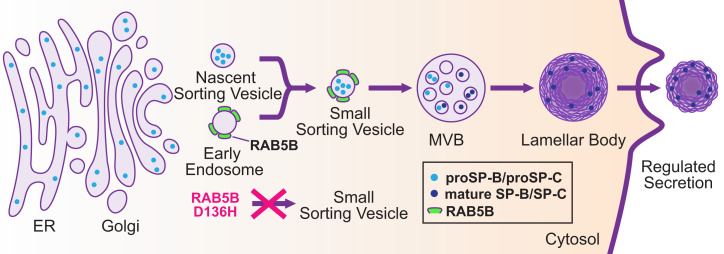Fig. 7.
Potential role for RAB5B in the surfactant protein–regulated secretion pathway. A model showing the regulated secretion pathway for surfactant in AT2 cells. Surfactant protein precursors proSP-B and proSP-C are translated in the ER and trafficked to the Golgi, where they bud off as cargo in nascent sorting vesicles. We propose that RAB5B-associated EEs fuse with prosurfactant containing nascent sorting vesicles to form small sorting vesicles, which subsequently fuse with the MVB, and then progress to the lamellar body for maturation and storage. Acidification during vesicular trafficking results in processing of proSP-B and proSP-C to mature SP-B and SP-C in the MVB/lamellar body. We further propose that dominant negative RAB5B p.D136H in the proband led to aberrant EEs that were defective in productive fusion with prosurfactant containing nascent sorting vesicles to generate functional small sorting vesicles (indicated by red X). We speculate that aberrant EEs containing RAB5B D136H, potentially as arrested fusion intermediates with nascent sorting vesicles containing proSP-B or proSP-C, are degraded. Such a mechanism would provide an explanation for reduced RAB5B as well as reduced EEA1 and the significant reduction of mature SP-B and SP-C. It is unknown if proSP-B and proSP-C are trafficked in the same or separate vesicles.

